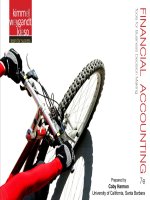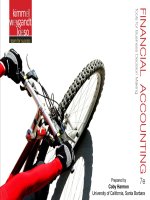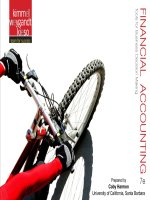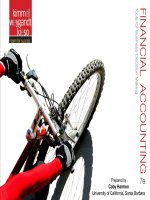Managerial accounting tool for business decision making chapter 13
Bạn đang xem bản rút gọn của tài liệu. Xem và tải ngay bản đầy đủ của tài liệu tại đây (1.27 MB, 45 trang )
Chapter
13-1
CHAPTER
CHAPTER 13
13
STATEMENT OF CASH FLOWS
Managerial Accounting, Fourth Edition
Chapter
13-2
Study
Study Objectives
Objectives
1.
Indicate the usefulness of the statement of
cash flows.
2.
Distinguish among operating, investing, and
financing activities.
3.
Prepare a statement of cash flows using the
indirect method.
4.
Analyze the statement of cash flows.
Chapter
13-3
Statement
Statement of
of Cash
Cash Flows
Flows
The
TheStatement
Statementof
of
Cash
CashFlows:
Flows:
Usefulness
Usefulnessand
and
Format
Format
Usefulness
Classifications
Significant
noncash activities
Format
Preparation
Indirect and direct
methods
Chapter
13-4
Preparing
Preparingthe
the
Statement
Statementof
of
Cash
CashFlows—
Flows—
Indirect
IndirectMethod
Method
Step 1: Operating
activities
Step 2: Investing
and financing
activities
Step 3: Net
change in cash
Using
UsingCash
Cash
Flows
Flowsto
toEvaluate
Evaluate
aaCompany
Company
Free cash flow
Usefulness
Usefulness of
of the
the Statement
Statement of
of Cash
Cash Flows
Flows
Provides information to help assess:
1. Entity’s ability to generate future cash flows.
2. Entity’s ability to pay dividends and obligations.
3. Reasons for difference between net income and net
cash provided (used) by operating activities.
4. Cash investing and financing transactions during
the period.
Chapter
13-5
LO 1 Indicate the usefulness of the statement of cash flows.
Classification
Classification of
of Cash
Cash Flows
Flows
Operating
Activities
Income
Statement
Items.
Chapter
13-6
Investing
Activities
Generally
Investments
and Long-Term
Assets.
Financing
Activities
Generally
Long-Term
Liability
and
Stockholders’
Equity .
LO 2 Distinguish among operating, investing, and financing activities.
Classification
Classification of
of Cash
Cash Flows
Flows
Classification of Typical Inflows and Outflows
Illustration 13-1
Operating activities - Income statement items
Cash inflows:
From sale of goods or services.
From interest received and dividends received.
Cash outflows:
To suppliers for inventory.
To employees for services.
To government for taxes.
To lenders for interest.
To others for expenses.
Chapter
13-7
LO 2 Distinguish among operating, investing, and financing activities.
Classification
Classification of
of Cash
Cash Flows
Flows
Classification of Typical Inflows and Outflows
Illustration 13-1
Investing activities - Changes in investments and longterm assets
Cash inflows:
From sale of property, plant, and equipment.
From sale of investments in debt or equity securities.
From collection of principal on loans to other entities.
Cash outflows:
To purchase property, plant, and equipment.
To purchase investments in debt or equity securities.
Chapter
13-8
To make loans to other entities.
LO 2 Distinguish among operating, investing, and financing activities.
Classification
Classification of
of Cash
Cash Flows
Flows
Classification of Typical Inflows and Outflows
Illustration 13-1
Financing activities - Changes in long-term liabilities
and stockholders’ equity
Cash inflows:
From sale of common stock.
From issuance of long-term debt (bonds and notes).
Cash outflows:
To stockholders as dividends.
To redeem long-term debt or reacquire capital stock
(treasury stock).
Chapter
13-9
LO 2 Distinguish among operating, investing, and financing activities.
Classification
Classification of
of Cash
Cash Flows
Flows
Significant Noncash Activities
1. Issuance of common stock to purchase assets.
2. Conversion of bonds into common stock.
3. Issuance of debt to purchase assets.
4. Exchanges of plant assets.
Companies report these activities in either a separate
schedule at the bottom of the statement of cash flows
or in a separate note or supplementary schedule to the
financial statements.
Chapter
13-10
LO 2 Distinguish among operating, investing, and financing activities.
Format
Format of
of the
the Statement
Statement of
of Cash
Cash Flows
Flows
Order of Presentation:
1.
Operating activities.
2.
Investing activities.
3.
Financing activities.
Direct Method
Indirect Method
The cash flows from operating activities section
always appears first, followed by the investing
and financing sections.
Chapter
13-11
LO 2 Distinguish among operating, investing, and financing activities.
Format
Format of
of the
the Statement
Statement of
of Cash
Cash Flows
Flows
Illustration 13-2
Chapter
13-12
LO 2 Distinguish among operating, investing, and financing activities.
Preparing
Preparing the
the Statement
Statement of
of Cash
Cash Flows
Flows
Three Sources of Information:
1. Comparative balance sheets
2. Current income statement
3. Additional information
Three Major Steps:
Chapter
13-13
Illustration 13-3
LO 3 Prepare a statement of cash flows using the indirect method.
Preparing
Preparing the
the Statement
Statement of
of Cash
Cash Flows
Flows
Three Major Steps:
Chapter
13-14
Illustration 13-3
LO 3 Prepare a statement of cash flows using the indirect method.
Preparing
Preparing the
the Statement
Statement of
of Cash
Cash Flows
Flows
Indirect and Direct Methods
Companies favor the indirect
method for two reasons:
1. It is easier and less costly
to prepare, and
2. It focuses on the
differences between net
income and net cash flow
from operating activities.
Chapter
13-15
LO 3 Prepare a statement of cash flows using the indirect method.
Preparing
Preparing the
the Statement
Statement of
of Cash
Cash Flows
Flows
Indirect
Method
Demonstration
Problem
Illustration 13-4
Chapter
13-16
LO 3 Prepare a statement of cash flows using the indirect method.
Preparing
Preparing the
the Statement
Statement of
of Cash
Cash Flows
Flows
Indirect
Method
Demonstration
Problem
Illustration 13-4
Chapter
13-17
LO 3 Prepare a statement of cash flows using the indirect method.
Preparing
Preparing the
the Statement
Statement of
of Cash
Cash Flows
Flows
Indirect
Method
Demonstration
Problem
Illustration 13-4
Chapter
13-18
LO 3 Prepare a statement of cash flows using the indirect method.
Preparing
Preparing the
the Statement
Statement of
of Cash
Cash Flows
Flows
Indirect
Method
Demonstration
Problem
Illustration 13-4
Chapter
13-19
LO 3 Prepare a statement of cash flows using the indirect method.
Preparing
Preparing the
the Statement
Statement of
of Cash
Cash Flows
Flows ––
Indirect
Indirect Method
Method
Step 1: Operating Activities
Determine net cash provided/used by operating
activities by converting net income from an accrual
basis to a cash basis.
Common adjustments to Net Income (Loss):
Add back non-cash expenses (depreciation and
amortization expense).
Deduct gains and add losses.
Changes in current assets and current liabilities.
Chapter
13-20
LO 3 Prepare a statement of cash flows using the indirect method.
Step
Step 1:
1: Operating
Operating Activities
Activities
Depreciation Expense
Although depreciation expense reduces net income, it
does not reduce cash. Depreciation is a noncash
charge. The company must add it back to net income.
Illustration 13-6
Chapter
13-21
LO 3 Prepare a statement of cash flows using the indirect method.
Step
Step 1:
1: Operating
Operating Activities
Activities
Question
Which is an example of a cash flow from an
operating activity?
a. Payment of cash to lenders for interest.
b. Receipt of cash from the sale of capital stock.
c. Payment of cash dividends to the company’s
stockholders.
d. None of the above.
Chapter
13-22
LO 3 Prepare a statement of cash flows using the indirect method.
Operating
Operating Activities
Activities
Loss on Sale of Equipment
Because companies report as a source of cash in the
investing activities section the actual amount of cash
received from the sale:
Any loss on sale is added to net income in the
operating section.
Any gain on sale is deducted from net income in
the operating section.
Chapter
13-23
LO 3 Prepare a statement of cash flows using the indirect method.
Operating
Operating Activities
Activities
Loss on Sale of Equipment
Illustration 13-7
Chapter
13-24
LO 3 Prepare a statement of cash flows using the indirect method.
Operating
Operating Activities
Activities
Changes to Noncash Current Asset Accounts
When the Inventory balance increases, the cost of
merchandise purchased exceeds the cost of goods sold.
Merchandise Inventory
1/1/11
Balance
10,000
Purchases
155,000
12/31/11 Balance
15,000
Cost of goods sold
150,000
As a result, cost of goods sold does not reflect cash
payments made for merchandise. The company deducts
from net income this inventory increase.
Chapter
13-25
LO 3 Prepare a statement of cash flows using the indirect method.









